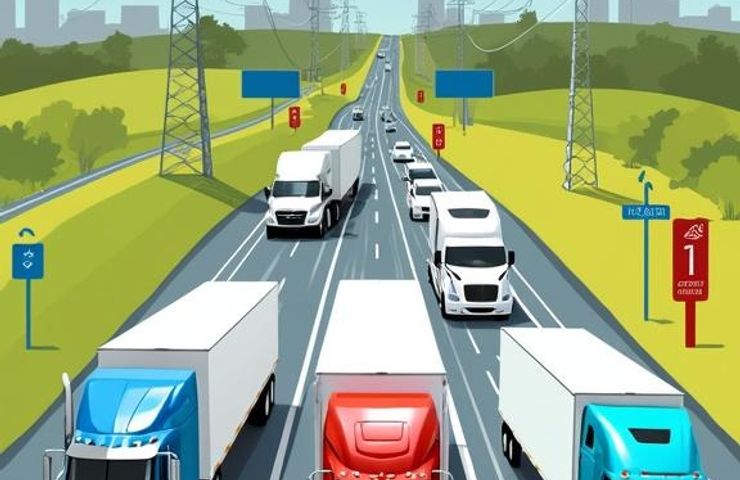
Hydrogen Fuel Cells Hit the Road: NACFE’s ‘Run on Less – Messy Middle’ Puts Zero-Emission Tech to the Test
October 27, 2025Thought decarbonizing heavy-duty trucking was a straight shot to electric or hydrogen? Think again. In September 2025, the North American Council for Freight Efficiency (NACFE) fired up its ‘Run on Less – Messy Middle’, sending 13 fleets on a real-world haul with a mix of diesel, natural gas, battery-electric and hydrogen fuel cell Class 8 trucks across North America. No magical solutions appeared. Instead, we walked away with a treasure trove of data: raw performance numbers, glaring gaps in the hydrogen infrastructure, and a stark truth—charting a course to zero-emission technology is anything but a straight line.
Here’s how we got here: Class 8 rigs make up just 9% of all trucks on the road, yet they’re belching nearly half of U.S. freight emissions. NACFE, a nonprofit born to push industrial decarbonization, kicked off its first ‘Run on Less’ back in 2017. Since then, they’ve cranked out research, published deep-dive reports and turned this demo into a biennial must-watch. For ‘Messy Middle,’ they teamed up with ACT News for live dispatches, called in Greenlane to stretch high-speed charging, and got heavyweight sponsors Cummins and Shell on board—because when you’re betting on sustainable energy, you need cold, hard numbers, not just hype.
Side-by-Side Showdown
Picture a scoreboard for trucking tech. NACFE’s 13 Class 8 trucks duked it out on uptime, efficiency and real-world chops:
- Hydrogen fuel cell: Perfect 100% uptime, clocking 4,076 miles and hitting 7.8 miles per kg of H₂. It matched diesel on range and serviceability—no small feat.
- Battery-electric: Strong 90% uptime, but charging pitstops spiked when chargers dried up in remote areas. Grid capacity and station density are still choke points.
- Natural gas: CNG/LNG rigs dished out diesel-like torque and, when running on renewable gas, chopped 15–20% off life-cycle CO₂ emissions.
- Diesel, biodiesel, renewable diesel: Our control group hit 99% uptime and shaved up to 10% off tailpipe CO₂ with bio-blends—but carbon zero? Not even close.
NACFE Executive Director Mike Roeth calls this experiment “the industry’s living laboratory.” Come November 3, they’ll drop the full dataset for anyone curious. Then get ready for workshops and a mechanical teardown report landing mid-2026.
On the Ground Reality
This was no PR stunt—these trucks were hauling real stuff: fresh-baked bread, lumber, automotive parts—you name it. They tackled urban drop-offs, cross-border runs and regional loops, mirroring day-to-day duty cycles. Fleets strapped in telematics to log every stop, throttle spike, idle minute and regen opportunity, feeding the beast of data. Meanwhile, ACT News kept the industry in the loop with daily updates, flagging every hiccup and high score.
Infrastructure Gaps
You can’t talk about cutting emissions without talking support networks. For battery-electric, Greenlane pushed its fast chargers to the brink, yet outside main corridors public stations often capped out at lower kW or vanished altogether. And the dream of a nationwide hydrogen infrastructure? Still in its infancy—drivers detoured 100 miles just to refill. CNG/LNG stations fared better but snagged on RNG permits and pipeline bottlenecks. Grid upgrades, transformer limits and red tape around hydrogen sites keep promising powertrains waiting in the wings.
Money & Mandates
If you’re running a fleet, three things eat your budget: fuel, drivers and maintenance. Swapping diesel for clean options needs at least a 15–20% cut in total cost of ownership. Then toss in EPA emission targets and California’s Advanced Clean Fleets rules, and you’ve got real pressure to embrace zero-emission technology. Federal hydrogen production tax credits under the IRA and state-level HVIP rebates for electrics are reshuffling the deck—fleets now crunch ROI numbers against grant deadlines, incentive windows and looming penalties. That’s why Cummins and Shell backed this demo: when you’ve got hard metrics, you sell new tech faster than hype alone ever could.
Collateral Wins & Warnings
The real gift here is NACFE’s open vault of uptime logs, energy-use profiles, refuel/recharge histories, maintenance flags and emissions stats. Fleets can plot pilot routes that play to each tech’s strengths. OEMs get a heads-up on reliability snags and can fine-tune their powertrains. Policymakers pinpoint where to pour funding for hydrogen fuel cells or bolstering the grid. NGOs and academics are already mining this trove to model decarbonization pathways and back smarter sustainable energy policies. Even supply chain chiefs are taking notes to shape greener procurement strategies. This series drives home one fact: achieving deep cuts in emissions is about the whole ecosystem, not just one silver-bullet technology.
Hard Truths
Let me be straight with you: the ‘messy middle’ is the name of the game until networks scale up and costs fall through the floor. Hydrogen fuel cells showed uptime that’d make diesel drivers jealous, but without a safety net of refueling stations, routes stay tight. Electric trucks rule when it comes to energy efficiency but buckle when chargers are AWOL. Natural gas is a halfway house—better for carbon but not the zero-emission answer we crave. Diesel blends keep wheels turning but won’t cut it for true carbon neutrality. If you’re hunting for a one-size-fits-all, you’ll end up stalled on the shoulder.
Next Moves
Mark your calendars for November 3—that’s when NACFE’s full dataset drops. Then brace yourself for a wave of workshops and policy roundtables spilling into early 2026, where fleets, OEMs and regulators will scramble over funding, incentive design and infrastructure priorities. The big question? Can charger networks densify and hydrogen infrastructure scale up before fleets are forced to pick a lane? Until that’s sorted, heavy-duty trucking will stay, brilliantly enough, in the messy middle.

 With over 15 years of reporting hydrogen news, we are your premier source for the latest updates and insights in hydrogen and renewable energy.
With over 15 years of reporting hydrogen news, we are your premier source for the latest updates and insights in hydrogen and renewable energy.